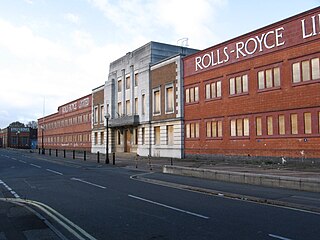
The Rolls-Royce Merlin is a British liquid-cooled V-12 piston aero engine of 27-litres capacity. Rolls-Royce designed the engine and first ran it in 1933 as a private venture. Initially known as the PV-12, it was later called Merlin following the company convention of naming its four-stroke piston aero engines after birds of prey.

Air Commodore Sir Frank Whittle, was an English engineer, inventor and Royal Air Force (RAF) air officer. He is credited with having invented the turbojet engine. A patent was submitted by Maxime Guillaume in 1921 for a similar invention which was technically unfeasible at the time. Whittle's jet engines were developed some years earlier than those of Germany's Hans von Ohain, who designed the first-to-fly turbojet engine.

Charles Stewart Rolls was a British motoring and aviation pioneer. With Henry Royce, he co-founded the Rolls-Royce car manufacturing firm. He was the first Briton to be killed in an aeronautical accident with a powered aircraft, when the tail of his Wright Flyer broke off during a flying display in Bournemouth. He was aged 32.

Sir Frederick Henry Royce, 1st Baronet, was an English engineer famous for his designs of car and aeroplane engines with a reputation for reliability and longevity. With Charles Rolls (1877–1910) and Claude Johnson (1864–1926), he founded Rolls-Royce.
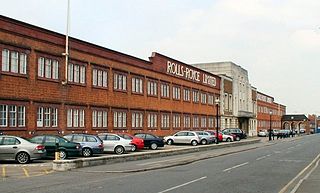
Osmaston is a suburb of the city of Derby, England. It is situated about 4 kilometres (2.5 mi) south of the city centre. It is written in the Domesday Book as Osmundestune. In 1307 the manor of Osmaston was granted to Robert Holland. It was the location of Osmaston Hall the residence of the Wilmot baronets of Osmaston.

The Rolls-Royce Meteor later renamed the Rover Meteor is a British tank engine that was developed during the Second World War. It was used in British tanks up to 1964. It was a result of co-operation between Leyland Motors and Rolls-Royce who between them in 1941 had suggested that a specialised de-rated version of the Merlin aero-engine would be highly suitable for use in armoured fighting vehicles.

The Rolls-Royce RB.37 Derwent is a 1940s British centrifugal compressor turbojet engine, the second Rolls-Royce jet engine to enter production. It was an improved version of the Rolls-Royce Welland, which itself was a renamed version of Frank Whittle's Power Jets W.2B. Rolls-Royce inherited the Derwent design from Rover when they took over their jet engine development in 1943.
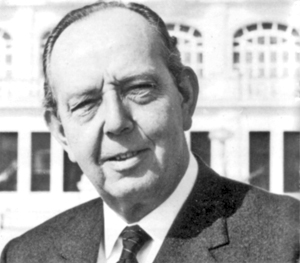
Sir Stanley George Hooker, CBE, FRS, DPhil, BSc, FRAeS, MIMechE, FAAAS, was a mathematician and jet engine engineer. He was employed first at Rolls-Royce where he worked on the earliest designs such as the Welland and Derwent, and later at Bristol Aero Engines where he helped bring the troubled Proteus turboprop and the Olympus turbojet to market. He then designed the famous Pegasus vectored thrust turbofan used in the Hawker Siddeley Harrier.

The Rolls-Royce RB.23 Welland was Britain's first production jet engine. It entered production in 1943 for the Gloster Meteor. The name Welland is taken from the River Welland, in keeping with the Rolls-Royce policy of naming early jet engines after rivers based on the idea of continuous flow, air through the engine and water in a river.

Rolls-Royce produced a range of piston engine types for aircraft use in the first half of the 20th century. Production of own-design engines ceased in 1955 with the last versions of the Griffon; licensed production of Teledyne Continental Motors general aviation engines was carried out by the company in the 1960s and 1970s.
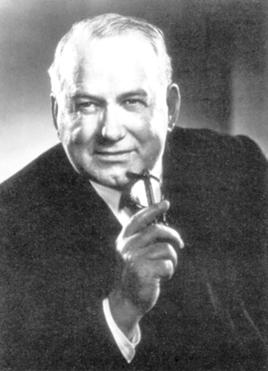
Ernest Walter Hives, 1st Baron Hives, was the one-time head of the Rolls-Royce Aero Engine division and chairman of Rolls-Royce Ltd.

Hucknall Aerodrome was a former general aviation and RAF aerodrome located 5 nmi north north-west of Nottingham, Nottinghamshire, England and west of Hucknall town. The aerodrome had been operated by the Merlin Flying Club since 1971 and then by Rolls-Royce Group plc. Before its closure, it was owned and operated by ITP Aero.
At the eastern end of Westminster Abbey in the Lady Chapel built by King Henry VII is the RAF Chapel dedicated to the men of the Royal Air Force who died in the Battle of Britain between July and October 1940.

Beatrice Shilling was a British aeronautical engineer, motorcycle racer and sports car racer. In 1949, Shilling was made an Officer of the Order of the British Empire.

The Supermarine Spitfire is a British single-seat fighter aircraft used by the Royal Air Force and other Allied countries before, during, and after World War II. Many variants of the Spitfire were built, from the Mk 1 to the Rolls-Royce Griffon-engined Mk 24 using several wing configurations and guns. It was the only British fighter produced continuously throughout the war. The Spitfire remains popular among enthusiasts; around 70 remain airworthy, and many more are static exhibits in aviation museums throughout the world.
Gerald Anthony Coles (1929–2004) was an English painter, printmaker, and stained glass designer.
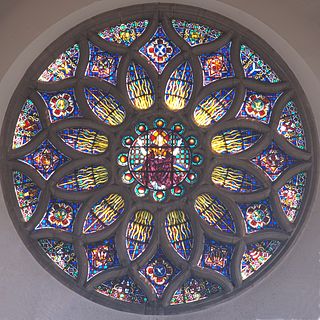
Hugh Ray Easton was a British stained-glass artist. His workshop was in Cambridge.

The Memorial to the Home of Aviation is a stone memorial sculpture at Eastchurch, on the Isle of Sheppey in the English county of Kent. The Grade II* listed memorial, unveiled in 1955, commemorates the early aviation flights from Leysdown and Eastchurch by members of the club that became the Royal Aero Club of Great Britain in 1910, and the air base established by the Royal Navy near Eastchurch in 1911.
William Arthur Robotham was a Rolls-Royce executive involved in the development of Rolls-Royce cars, during World War II of tanks and tank engines, and post-war of Rolls-Royce and Bentley cars complete with bodies and then of industrial petrol and diesel engines.

















